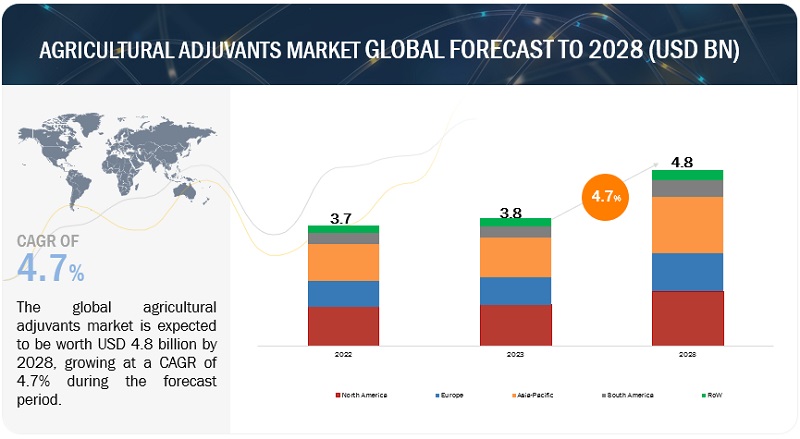According to a research report"Agriculture Adjuvants MarketFormulation (Suspension Concentrates, Emulsified Concentrates), Adoption Stage (In-Formulation, Tank Mix), Function (Activator Adjuvants, Utility Adjuvants), Application (Insecticide), Region - Global Forecast to 2028"published by MarketsandMarkets, the global agriculture adjuvants market will grow from USD 3.8 billion in 2023 to USD 4.8 billion by 2028, growing at a CAGR of 4.7% during the forecast period. Farmers are increasingly looking for ways to improve the efficiency of crop protection programs reduce the environmental impact. Adjuvants boost the performance of pesticides and fertilizers by increasing their efficacy, coverage, and retention, thus making farming more sustainable by reducing the number of chemicals used. The need for increased food production and sustainable crop protection through agricultural adjuvants is growing.

Download PDF Brochure:
https://www.marketsandmarkets.com/pdfdownloadNew.asp?id=1240
The cereals grains crop type segment held the largest market share in the agricultural adjuvants market in 2022
Agricultural adjuvants play an essential role in agricultures cereal and grain segment. According to FAO, in 2022/23, global cereal production stood at 2,786.6 million tons, with wheat contributing 800.9 million tons and rice 516.9 million tons of production. With the growing production and demand for cereals grains, the utilization of agricultural adjuvants is growing. Celeral grains are consumed as a staple food in most countries worldwide, and protecting these crops from weather, pests, and weeds requires agricultural adjuvants. This is increasing the demand for agricultural adjuvants in cereals grains.
Tank-mix adjuvants are in the fastest-growing adoption stage in the agricultural adjuvants market.
Adjuvants are added separately into the spray tank, and pesticides or herbicides are known as tank-mix adjuvants. Tank-mix adjuvant ensures high performance, drift reduction, improved spray coverage, and increased absorption into the target crops. The farmers are increasingly using tank-mix agricultural adjuvants as they can customize and adjust on a case-to-case basis. Customization ensures desired performance characteristics while treating the targeted pest or weed; hence, the demand has been accelerating.
Request Sample Pages:https://www.marketsandmarkets.com/requestsampleNew.asp?id=1240
North America held the largest share of the agricultural adjuvants market in 2022
The demand for agriculture adjuvants in North America is witnessing significant growth due to several key factors. The cultivation of industrial crops such as corn and soybean has been gaining pace in North American countries, driving the agricultural adjuvants market growth. According to the United States Department of Agriculture (USDA) reports, in 2022, the US produced 13.7 billion bushels of corn and 4.28 billion bushels of soybean. Though the production of both these crops fell in 2021, the consumption of agricultural adjuvants is growing in the region at a significant pace.
Major players operating in the agricultural adjuvants market include Corteva Agriscience (US), Evonik Industries AG (Germany), Croda International Plc (UK), Nufarm Limited (Australia), Solvay SA (Belgium), BASF SE (Germany), Huntsman International LLC. (US), Clariant AG (Switzerland), Helena Agri-Enterprises, LLC (US), WILBUR-ELLIS AGRIBUSINESS (US), Precision Laboratories, LLC (US), and CHS Inc. (US).
























